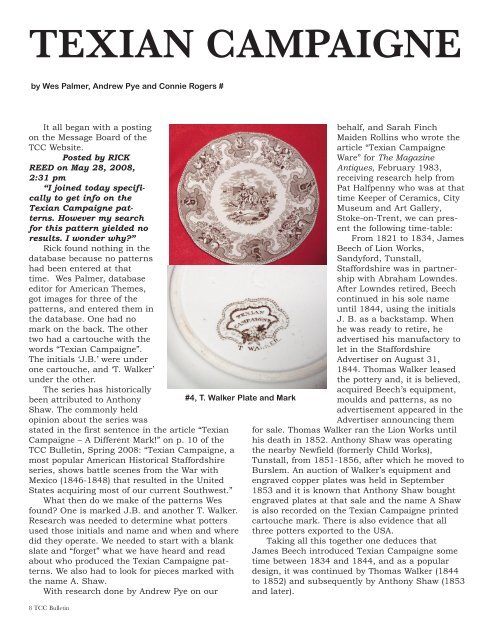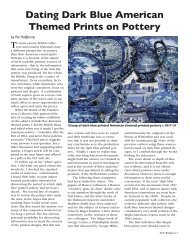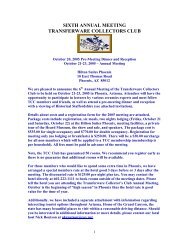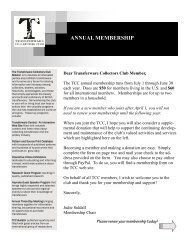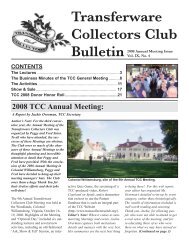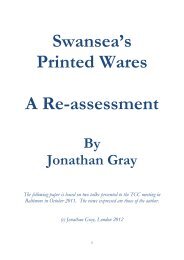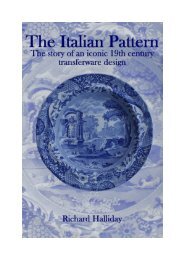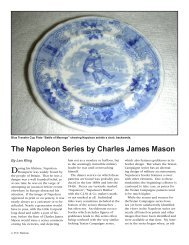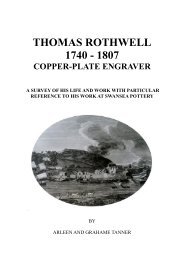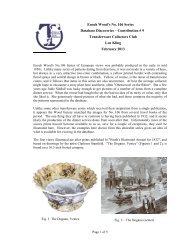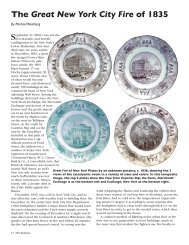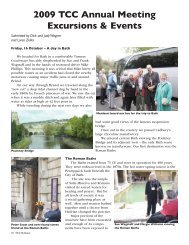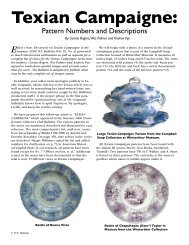Texian Campaigne - Transferware Collectors Club
Texian Campaigne - Transferware Collectors Club
Texian Campaigne - Transferware Collectors Club
Create successful ePaper yourself
Turn your PDF publications into a flip-book with our unique Google optimized e-Paper software.
TEXIAN CAMPAIGNE<br />
by Wes Palmer, Andrew Pye and Connie Rogers #<br />
It all began with a posting<br />
on the Message Board of the<br />
TCC Website.<br />
Posted by RICK<br />
REED on May 28, 2008,<br />
2:31 pm<br />
“I joined today specifically<br />
to get info on the<br />
<strong>Texian</strong> <strong>Campaigne</strong> patterns.<br />
However my search<br />
for this pattern yielded no<br />
results. I wonder why?”<br />
Rick found nothing in the<br />
database because no patterns<br />
had been entered at that<br />
time. Wes Palmer, database<br />
editor for American Themes,<br />
got images for three of the<br />
patterns, and entered them in<br />
the database. One had no<br />
mark on the back. The other<br />
two had a cartouche with the<br />
words “<strong>Texian</strong> <strong>Campaigne</strong>”.<br />
The initials ‘J.B.’ were under<br />
one cartouche, and ‘T. Walker’<br />
under the other.<br />
The series has historically<br />
been attributed to Anthony<br />
Shaw. The commonly held<br />
opinion about the series was<br />
stated in the first sentence in the article “<strong>Texian</strong><br />
<strong>Campaigne</strong> – A Different Mark!” on p. 10 of the<br />
TCC Bulletin, Spring 2008: “<strong>Texian</strong> <strong>Campaigne</strong>, a<br />
most popular American Historical Staffordshire<br />
series, shows battle scenes from the War with<br />
Mexico (1846-1848) that resulted in the United<br />
States acquiring most of our current Southwest.”<br />
What then do we make of the patterns Wes<br />
found? One is marked J.B. and another T. Walker.<br />
Research was needed to determine what potters<br />
used those initials and name and when and where<br />
did they operate. We needed to start with a blank<br />
slate and “forget” what we have heard and read<br />
about who produced the <strong>Texian</strong> <strong>Campaigne</strong> patterns.<br />
We also had to look for pieces marked with<br />
the name A. Shaw.<br />
With research done by Andrew Pye on our<br />
8 TCC Bulletin<br />
#4, T. Walker Plate and Mark<br />
behalf, and Sarah Finch<br />
Maiden Rollins who wrote the<br />
article “<strong>Texian</strong> <strong>Campaigne</strong><br />
Ware” for The Magazine<br />
Antiques, February 1983,<br />
receiving research help from<br />
Pat Halfpenny who was at that<br />
time Keeper of Ceramics, City<br />
Museum and Art Gallery,<br />
Stoke-on-Trent, we can present<br />
the following time-table:<br />
From 1821 to 1834, James<br />
Beech of Lion Works,<br />
Sandyford, Tunstall,<br />
Staffordshire was in partnership<br />
with Abraham Lowndes.<br />
After Lowndes retired, Beech<br />
continued in his sole name<br />
until 1844, using the initials<br />
J. B. as a backstamp. When<br />
he was ready to retire, he<br />
advertised his manufactory to<br />
let in the Staffordshire<br />
Advertiser on August 31,<br />
1844. Thomas Walker leased<br />
the pottery and, it is believed,<br />
acquired Beech’s equipment,<br />
moulds and patterns, as no<br />
advertisement appeared in the<br />
Advertiser announcing them<br />
for sale. Thomas Walker ran the Lion Works until<br />
his death in 1852. Anthony Shaw was operating<br />
the nearby Newfield (formerly Child Works),<br />
Tunstall, from 1851-1856, after which he moved to<br />
Burslem. An auction of Walker’s equipment and<br />
engraved copper plates was held in September<br />
1853 and it is known that Anthony Shaw bought<br />
engraved plates at that sale and the name A Shaw<br />
is also recorded on the <strong>Texian</strong> <strong>Campaigne</strong> printed<br />
cartouche mark. There is also evidence that all<br />
three potters exported to the USA.<br />
Taking all this together one deduces that<br />
James Beech introduced <strong>Texian</strong> <strong>Campaigne</strong> some<br />
time between 1834 and 1844, and as a popular<br />
design, it was continued by Thomas Walker (1844<br />
to 1852) and subsequently by Anthony Shaw (1853<br />
and later).
of James K. Polk. Mexico did not recognize the<br />
annexation of Texas, which it still considered a<br />
rebel province of Mexico. Between 1846 and 1848,<br />
the United States and Mexico went to war over the<br />
disputed lands. Indeed some of the views have<br />
been “identified” as particular battles in that war<br />
by using titles of lithographs by Nathaniel Currier<br />
(such as The Battle of Monterey, Resaca de la<br />
Palma and Chapultepec). However, from our<br />
research on the makers of the pattern, we see that<br />
it was already in production long before the<br />
Mexican-American War began, and the earliest of<br />
Currier’s lithographs are dated 1846 and 1847.<br />
There is only one conclusion that fits the facts,<br />
and that is the <strong>Texian</strong> <strong>Campaigne</strong> series was introduced<br />
by James Beech about 1837-40 to mark the<br />
Texas Revolution (1835-36) or first <strong>Texian</strong><br />
<strong>Campaigne</strong>, when Texas achieved its independence.<br />
We know the design was continued<br />
unchanged by his successors. Incidentally, ‘<strong>Texian</strong>’<br />
was the original form of the word ‘Texan’. The let-<br />
#6, 7 ½” <strong>Texian</strong> Plate w/ “J.B.” Mark<br />
The cartouche illustrated with the words <strong>Texian</strong><br />
<strong>Campaigne</strong> and maker’s initials or name does not<br />
include names of the individual patterns. Most of<br />
the patterns appear on no more than four shapes,<br />
as it was a series made for dinnerware with changing<br />
patterns on different pieces. Since our research<br />
began in May, the initials J. B. have been found on<br />
over 20 items in 9 of the documented patterns. T.<br />
W. or T. Walker has been found on 2 patterns and<br />
A. Shaw on 3. These facts support the belief that<br />
most of the production was done before 1844.<br />
This, however, brings up a problem with the<br />
previously accepted time line. The series, reputedly,<br />
depicts romanticized views of the United States’<br />
victory in the Mexican-American War. The war<br />
resulted from the annexation of Texas, in 1845, by<br />
the United States Congress during the Presidency<br />
#5, Purple Transfer <strong>Texian</strong> Serving Bowl with Shaw Mark<br />
TCC Bulletin 9
ter ‘e’ added to Campaign may<br />
have been a British addition to<br />
give the name greater distinction<br />
– as in Ye Olde Curiosity<br />
Shoppe.<br />
How then, did Anthony Shaw<br />
and the Mexican War get into the<br />
picture? Most early writers gave<br />
little attention to the series, just<br />
listing an entry or two with the<br />
printed <strong>Texian</strong> <strong>Campaigne</strong> cartouche<br />
mark, usually with the<br />
initials JB beneath. Ellouise<br />
Baker Larsen (1939) came along<br />
and delved more deeply into the<br />
subject. She took into account<br />
Shaw’s occupation of the Mersey<br />
Pottery at Burslem beginning at<br />
1850 according to Jewitt,<br />
although he was at Tunstall<br />
1851-56 and moved to Burslem<br />
in 1856. Using that time period,<br />
though, she did her best to find<br />
where the designs came from<br />
and what inspired them. Larsen<br />
realized that none of the scenes<br />
are direct copies of Currier’s<br />
prints. However, she held to the<br />
idea that a few details may have<br />
been borrowed from the prints<br />
and used for the <strong>Texian</strong><br />
<strong>Campaigne</strong> patterns. Pursuing<br />
all leads, Larsen sent a number<br />
of photos of china marked <strong>Texian</strong><br />
<strong>Campaigne</strong> to leading authorities<br />
of Mexican War scenes to have<br />
them checked against countless<br />
lithographs. She received no confirmations.<br />
No exact source pictures<br />
were found.<br />
She notes that “the series<br />
was for many years known only<br />
by its solitary letters on the<br />
reverse, J. B., beneath the mark:<br />
<strong>Texian</strong> <strong>Campaigne</strong>, enclosed by a<br />
scroll.” She states that in 1947 a<br />
platter was donated to the New<br />
York Historical Society that was<br />
signed by the maker. “The letters<br />
J. B. were replaced by the name:<br />
A Shaw.” This is when she got<br />
the idea that J. B. was the<br />
10 TCC Bulletin<br />
#2, Purple Transfer Plate with <strong>Texian</strong><br />
Scene marked Tampico<br />
designer of the pattern. Her<br />
explanation of the letters J.B.<br />
has continued on down until the<br />
present day by authors and collectors.<br />
We wrote a letter of<br />
inquiry, and a reply was received<br />
June 21, 2008 from the New<br />
York Historical Society. The<br />
scene on the platter was<br />
described. We learned that the<br />
platter is on display and bears<br />
the title: “Platter: Texan<br />
Campaign 1850-1878.<br />
Artist/Maker: Anthony Shaw. “<br />
The Curatorial Remarks: “The<br />
‘<strong>Texian</strong> Campaign’ represents a<br />
battle in the Mexican War. The<br />
initials ‘J.B.’ may refer to James<br />
Broadhurst of Longton (and later<br />
Fenton), Staffordshire, who used<br />
this underglaze mark from 1862-<br />
1870.” Evidently, Larsen never<br />
saw the platter. That it was<br />
#5, Rare <strong>Texian</strong> Mug marked<br />
Valparaiso<br />
No. 65, Polychromed Napoleon<br />
Plate by William Smith & Co.<br />
marked A. Shaw was hearsay;<br />
however, the myth has endured<br />
for all these years.<br />
We have reviewed everything<br />
previously written about <strong>Texian</strong><br />
<strong>Campaigne</strong> and the evidence presented<br />
by all the writers actually<br />
supports the attribution to
James Beech, Thomas Walker<br />
and Anthony Shaw. The Finch<br />
article is backed by the research<br />
of Pat Halfpenny. The frequency<br />
that the different initials/names<br />
are found on backstamps on surviving<br />
pieces today gives added<br />
weight to the attribution and<br />
chronology.<br />
What has got in the way over<br />
the years is the claim that<br />
<strong>Texian</strong> <strong>Campaigne</strong> depicts actual<br />
battles and events in the<br />
Mexican War. That somehow<br />
became accepted as a given, and<br />
all the other facts were distorted<br />
to fit; yet nobody has ever found<br />
a source print for any <strong>Texian</strong><br />
<strong>Campaigne</strong> scene. Indeed some<br />
have commented on the similarity<br />
between <strong>Texian</strong> <strong>Campaigne</strong><br />
scenes and those found in paintings<br />
and engravings of European<br />
wars, notably those of Napoleon.<br />
The uniforms and hats are more<br />
European than US or Mexican<br />
and there is no sign of the flag of<br />
either the US or Mexico. None of<br />
the scenes can be visually identified<br />
with an actual place or<br />
scene from the Mexican War. No<br />
specific battles are given on the<br />
backstamp. There is not a single<br />
fact supporting the Mexican War<br />
scenario.<br />
There are now 11 scenes<br />
entered in the Database for<br />
<strong>Texian</strong> <strong>Campaigne</strong> and we have<br />
chosen to number each scene in<br />
the database to identify them,<br />
but retain the 5 named Battle<br />
Scenes as alternative pattern<br />
names to facilitate searches<br />
using the previously accepted<br />
names. Our numbering system<br />
(1-9) follows the list as presented<br />
in Margie Williams’ list on p. 73<br />
in American Historical English<br />
Pink:<br />
1 Battle of Buena Vista<br />
2 Battle of Chapultepec<br />
3 Battle of Monterey<br />
4 Battle of Palo Alto<br />
5 Battle of Resaca de la Palma<br />
6 General on Rearing Horse<br />
7 Officer on Foot, et al<br />
8 Officer and Men at Rest<br />
around Fire, et al<br />
9 Two Officers on Horse, et al<br />
10 Battle by a Bridge<br />
11 Unidentified<br />
Our thanks to Henri Gadbois,<br />
a docent of the Bayou Bend<br />
Museum and Gardens, Houston,<br />
Texas, who has provided photos<br />
from the collection as well as<br />
insights into the patterns. A further<br />
two patterns from Bayou<br />
Bend are illustrated here – primarily<br />
because of the marks. The<br />
Staffordshire potters exported<br />
transferware to many markets<br />
beside the US. A plate bearing<br />
pattern #2 has a “Tampico”<br />
mark, and a blue printed mug<br />
with pattern #5 has a mark<br />
“Valparaiso”. These items do not<br />
have the Texican <strong>Campaigne</strong><br />
backstamp, but are clearly the<br />
same scenes, although the printing<br />
plates look to have become<br />
worn by this time, so the print is<br />
not as crisp and clear as earlier<br />
pieces. They illustrate how the<br />
Staffordshire potters were prepared<br />
to stretch the life of a<br />
design, by giving it a new backstamp<br />
and possibly a new<br />
name.<br />
It does appear that around<br />
1840, wars and battles were in<br />
vogue as tableware. C J Mason<br />
produced a series pattern visually<br />
similar to <strong>Texian</strong> <strong>Campaigne</strong>,<br />
which is known as the Napoleon<br />
series and the battles depicted<br />
are named in the backstamps.<br />
The similarities are such that<br />
one wonders if the same engraving<br />
shop produced both patterns.<br />
William Smith & Co produced<br />
Napoleon’s Victories and the final<br />
photo shown here of one of their<br />
wares may bring to mind the #2<br />
pattern seen on the Tampico<br />
marked plate. Copeland &<br />
Garrett to redress the balance<br />
introduced their Wellington<br />
series.<br />
We realize that what is<br />
reported here does change the<br />
<strong>Texian</strong> <strong>Campaigne</strong> collecting<br />
landscape in a major way, but<br />
the evidence is substantial. We<br />
would welcome more opinions<br />
and reports of more pieces of<br />
<strong>Texian</strong> <strong>Campaigne</strong>. There have<br />
been some reports of teawares<br />
and a ewer and bowl featured in<br />
the Eugene Fleischer Collection<br />
auction in 2007: however, the<br />
backstamps are not known.<br />
A final thought, before collectors<br />
begin the search for source<br />
prints for the 1835-36 War: our<br />
belief is that the War was the<br />
inspiration for <strong>Texian</strong> <strong>Campaigne</strong><br />
and nothing more. The pattern<br />
was not introduced to chronicle<br />
or depict what actually happened,<br />
but is really Romantic<br />
Staffordshire – if a war can be<br />
described as romantic. Time has<br />
shown that without doubt James<br />
Beech’s choice of pattern name<br />
was a shrewd piece of<br />
marketing.<br />
An interesting illustrated article<br />
“<strong>Texian</strong> <strong>Campaigne</strong> Pottery”<br />
by Wesley & Sallie Tucker<br />
Anderson (The Boll Weevil) can<br />
be found on the website of the<br />
Antiques Council.<br />
http://antiquescouncil.com/<br />
organiz.htm. Look under<br />
FOCUS. Ceramics: Pottery.<br />
See sidebar<br />
next page<br />
TCC Bulletin 11
<strong>Texian</strong> <strong>Campaigne</strong>: The Mystique Unraveled!!<br />
Editor’s Note: Two separate postings, one<br />
in the Spring 2008 TCC Bulletin concerning a<br />
mark on a <strong>Texian</strong> <strong>Campaigne</strong> plate previously<br />
unseen by TCC Member and American<br />
Historical Staffordshire dealer Bill Kurau,<br />
and the other to an entry on the TCC<br />
Message board in May by Rick Reed seeking<br />
information on the <strong>Texian</strong> <strong>Campaigne</strong> pattern,<br />
has led to significant discussion and research<br />
by other members of the TCC. Both the letter<br />
from Lucille Gaignault and the article by Wes<br />
Palmer, Andrew Pye and Connie Rogers were<br />
received by the Bulletin at approximately the<br />
same time, and because there is so much relevant<br />
information in both, your editor has<br />
decided to print the two pieces for the benefit<br />
of the TCC Membership.<br />
To the Editor:<br />
Here is a reply to “<strong>Texian</strong> <strong>Campaigne</strong><br />
– A Different Mark” on page 10 of the Spring<br />
2008 TCC Bulletin.<br />
Researching this pattern is akin to traversing<br />
a quicksand box in stiletto heels: difficult<br />
at every step, given the quantity of<br />
misinformation available. Once an “UNfact”<br />
appears in print, it stays there for eternity.<br />
Charles James Mason & Co. potted<br />
“Napolean” ca. 1829-1845. Around 1838,<br />
James Beech, Tunstall, fiddled slightly with<br />
the border and some details and marketed<br />
“<strong>Texian</strong> <strong>Campaigne</strong>,” presumably his egregious<br />
spelling, to appeal to the American<br />
market. (It DID!)<br />
There are several James Beeches listed<br />
in Kowalsky under the “J.B.” marks (p. 548,<br />
Encyclopedia of Marks), but this is the only<br />
one in Tunstall whose dates fit our present<br />
report. He produced “<strong>Texian</strong>” from ca. 1838-<br />
1845.<br />
In 1845, James Beech either died or<br />
retired, and the Tunstall works passed to his<br />
son-in-law, Thomas Walker, who potted<br />
“<strong>Texian</strong>” until 1852 or 1853, when Anthony<br />
Shaw took over and produced the pattern<br />
until ca. 1856; how he acquired the pattern<br />
from Walker I do not know, but both worked<br />
in Tunstall.<br />
Many of my reference books have a paragraph<br />
about Anthony Shaw’s “<strong>Texian</strong><br />
<strong>Campaigne</strong>” and then as proof, show a backstamp<br />
clearly marked “J.B.”! Isn’t this carrying<br />
dyslexia a bit far? Remembering<br />
Winterthur’s impressive pile of “<strong>Texian</strong>”<br />
plates, in the stacks, not on exhibit, I called<br />
Leslie Grigsby, Curator of Ceramics and<br />
Glass, who was very helpful.<br />
The Winterthur computer records James<br />
Beech, James Broadhurst (who’s he?) and<br />
Anthony Shaw as the various potters of<br />
Winterthur’s sixty-odd pieces of “<strong>Texian</strong>,”<br />
mostly plates and a few hollow ware items.<br />
But HA! A more recent computer list<br />
shows that ALL the pieces in the collection<br />
are marked either “J.B.” or nothing at all.<br />
Leslie suggested that I call Michael<br />
Brown, Curator of the Bayou Bend<br />
Collection, a branch of the Museum of Fine<br />
Arts, Houston. Michael, too, was very helpful.<br />
As befits a Texas museum, the Bayou<br />
Bend collection holds about 120 pieces of<br />
“<strong>Texian</strong>.” Two bear genuine printed Anthony<br />
Shaw backstamps (at last!), and one item<br />
shows both a printed and an impressed<br />
“T.W.” The remaining pieces are marked<br />
“J.B.”<br />
My own 8 ¼” (210 mm) pink “<strong>Texian</strong>”<br />
plate has a backstamp very similar to the<br />
one shown on page 10 of the Spring<br />
Bulletin, but with gentler indentations.<br />
Below the backstamp is a vague “blob”<br />
which could be a ‘T’ or a ‘J’ but the rest is<br />
absent.<br />
A final remark: could this “J.B.” be the<br />
potter of Eastern plants?<br />
Lucille Gaignault<br />
Princeton, NJ<br />
12 TCC Bulletin


